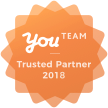You’re at the make or break stage of your startup: you have an MVP and are ploughing ahead. The decisions you make now about funding and growth will determine the course your company takes and how you engage with both your employees and customers.
I don’t see a one size fits all solution to startup funding. Instead, it’s worth taking the time to sort through all the options and figure out the best one for your startup. Working off of a lean canvas is a solid way to make sure you look at funding options that support your long-term goals.
The first question to ask yourself is what role your MVP is playing for your startup. Is it testing the assumptions embedded in your business plan or is it already going to generate a sustainable revenue stream?
Bootstrapping your startup

Photo by Melissa Walker Horn on Unsplash
With all the buzz surrounding VC funding, viral growth and becoming a unicorn, it’s easy to forget there’s another way. Plenty of companies have quietly become successful without taking external funding. For those keen on this arduous path, Basecamp, MailChimp and MacPaw are classic examples of bootstrapping in action.
Let’s say you build your MVP for 15k, and then optimize your cloud hosting so you’re spending less than 100 dollars a month—turning a month to month profit while growing your startup as a side hustle is a real thing. You don’t have to get millions in VC funding to be a successful business. That’s why I encourage every founder to consider this path. If you can hit the projections in your lean canvas without funding and turn a profit, rock on.
Bootstrapping isn’t a lifelong monastic vow. There are plenty of cases of companies spending years turning a profit before looking for external funding. Grammarly took this approach for 8 years (and reminded me this sentence was passive, so I rewrote it). Having a profitable and productive ‘bootstrapped era’ makes you all the more appealing to outside investors if you ultimately decide to go that route.
Friends, Family and Fools
Your circle of friends and relatives is the first place to look for external funding. At first you can expect the harsh reality that ‘no [founder] is accepted in his own country.’ But, when those who know you best aren’t ready to invest in your startup, that could be a red flag for other investors.
You don’t need to have millionaire friends! A few people that are willing to help you keep afloat while you’re still building your core client base is enough to start. This speaks volumes—that not only you believe in your business. While this approach isn’t a realistic way to generate millions, I’ve seen successful projects work with funding from friends, family and fools. I’ve even been the fool or friend more than once, depending on how you look at it!
Incubators and accelerators
Joining an incubator or accelerator is a great option if you’re looking for mentorship and community as well as cash. Exact arrangements vary, but the general idea is that you trade equity in your company for investment and access to the incubator’s resources. You get access to accountants, attorneys and other professionals plus shared space and knowledge sharing between startups.
Incubators are a great place to find camaraderie with other founders and build off of each other’s experience. In the best case, you’ll get direct mentorship from senior founders within the incubator. For rookie founders, this is can be critical.
The fundamentals are same whether you’re making a business plan for yourself, your friends or pitching to an incubator. A proof of concept or working MVP, a solid business plan and a pitch deck that sells your startup are clutch. Some of the most well known incubators are Y Combinator and 500 Startups, but they’re only the tip of the iceberg. Dropbox is one of the most famous Y Combinator ‘graduates’.
Faustian deals
Venture capital and angel investors are the granddaddies of startup funding. If you need rocket fuel for your startup to blast off, this is where to look. This is the path that companies like Facebook and Google took: use capital intensive growth to capture market share early on and then become profitable.
If you’re still unfunded, the seed round comes first. You’re most likely to attract angel investors at this point. As you gain more traction, you’re ready to turn to venture capital. If you’re serious about getting to this stage, Y Combinator’s guide to funding is a must read.
Keep in mind that as you accept more funding from VCs and angel investors, you begin to lose control of your company. You’re no longer a benevolent dictator for life. So make sure that you have a common vision and shared values as VCs will want a seat on your board of directors. Sharing a common vision with an investor is a powerful boon: it can bring you mentorship, new opportunities and meetings with clients.
Bonus funding…grants and crowdfunding!
Governments and nonprofits аre keen to jump start local economies by encouraging startups and small businesses. Too many founders overlook grants as a way of getting their business going, but there are tons of them out there! Check your local and national government plus nonprofits that you can partner with.

Crowdfunding is another option to explore. Many creative startups live off of Patreon, kickstarter campaigns and even Kiva loans. If more traditional options don’t work for you, it’s worth exploring this less traveled road.
Find what works for you
I’ve managed development projects for startups that have chosen each of the above paths. That’s why I wouldn’t say that one way of securing funding is the best or only way to go. Instead, I encourage the founders I work with to nail the basics: MVP, lean canvas, cash flow plan and pitch deck. Once you have those down, you should have a clear idea of what path is right for you. Additionally, you’ll already have the materials you need to start pitching your startup to investors.








